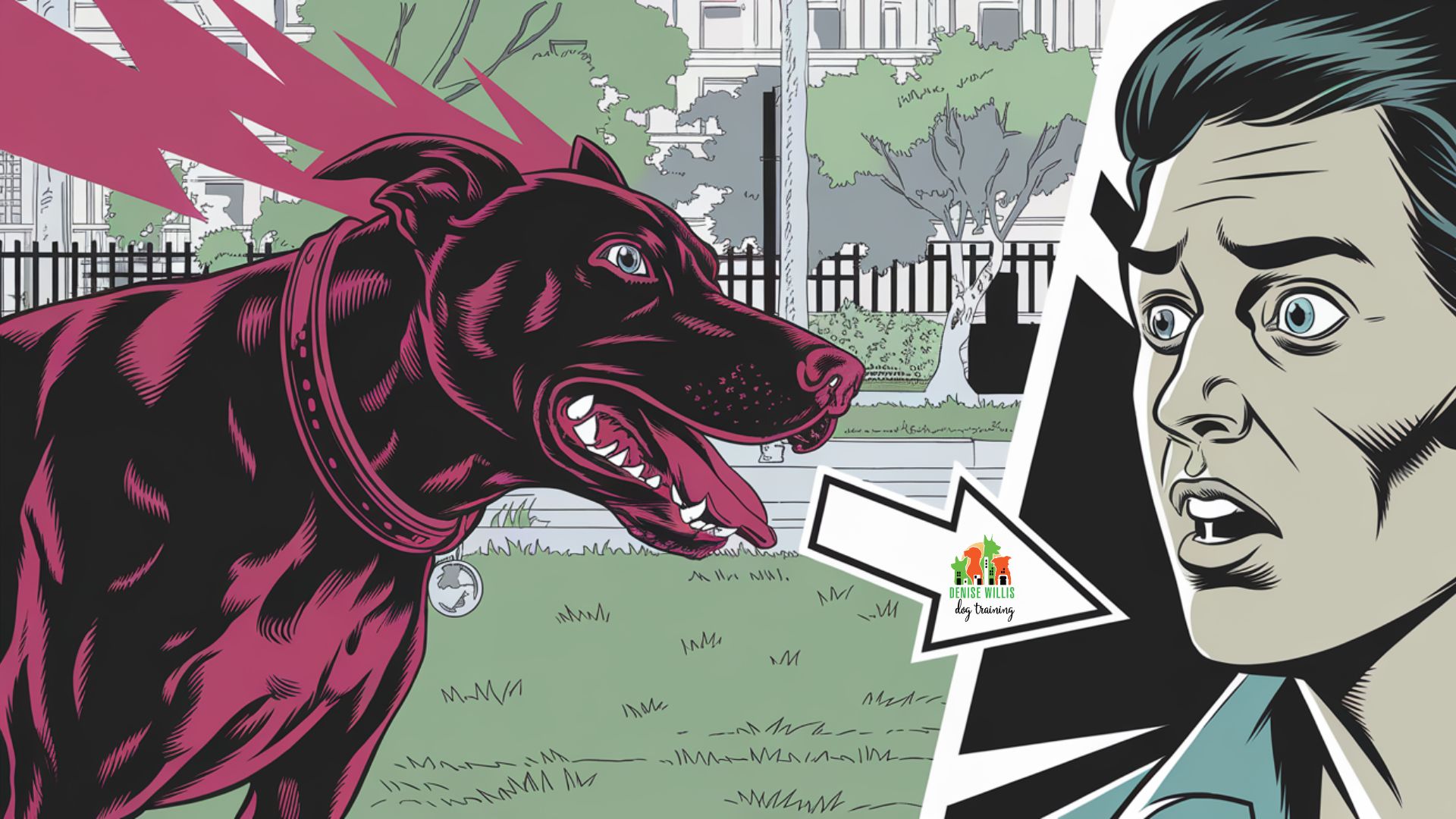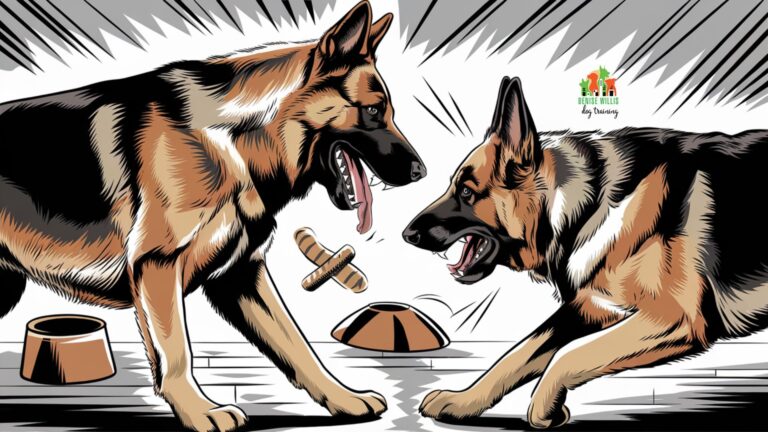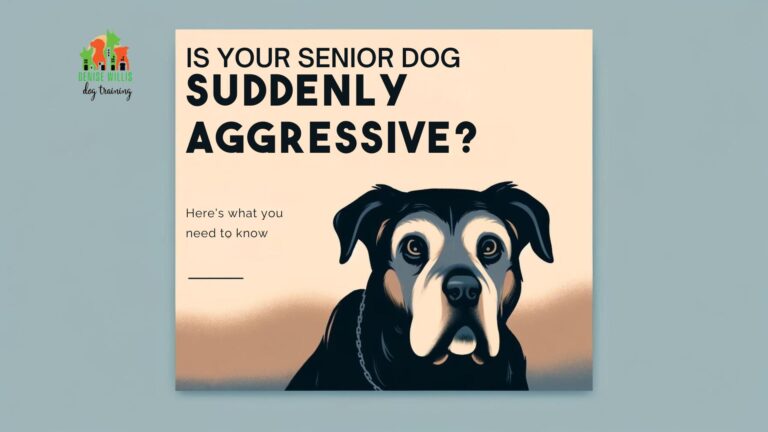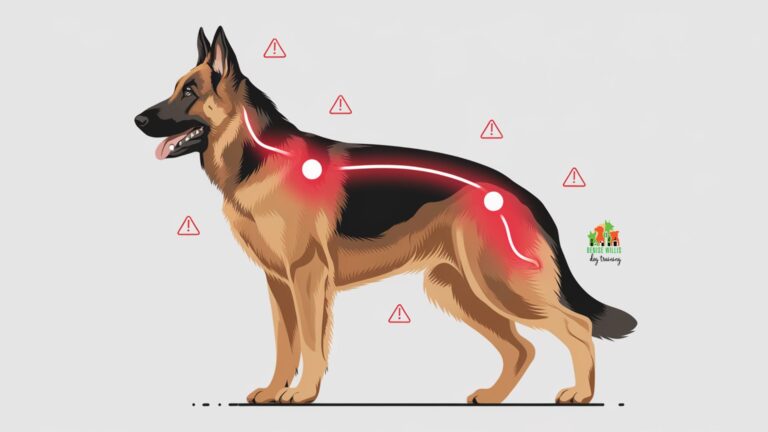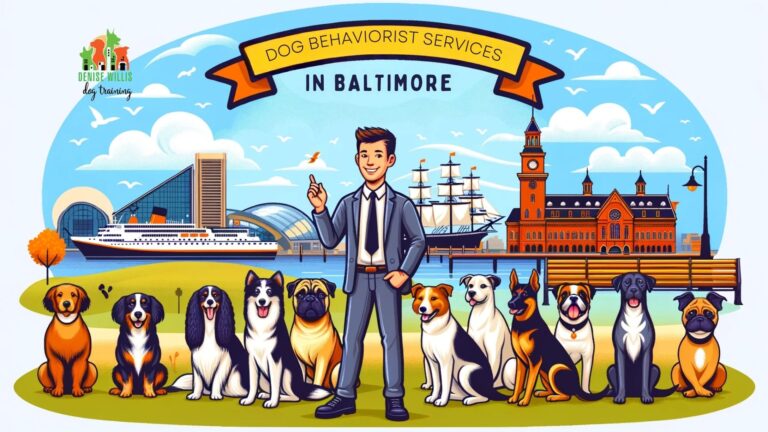When Frustration Strikes: Understanding and Preventing Redirected Dog Aggression
📍 Service Area Notice: DW Dog Training provides in-person training services exclusively in the Greater Baltimore area. While our blog content is designed to help dog owners internationally, our hands-on training services are locally focused. For readers outside our service area, we hope you find value in our articles and welcome you to reach out with questions!
Ever witnessed your otherwise sweet pup suddenly snap at you while you’re trying to pull them away from a fence-line dispute with the neighbor’s dog?
Or, perhaps your normally gentle companion redirected a growl your way when you attempted to break up a squabble over a prized chew toy?
Welcome to the perplexing world of redirected dog aggression, where your dog’s frustration finds the nearest outlet, which unfortunately might be you.
Redirected aggression occurs when a dog, unable to address the actual source of their frustration or arousal, transfers that energy to a more accessible target. According to experts, this isn’t a separate form of aggression but rather a manifestation of thwarted aggression or arousal.
It’s essentially the canine equivalent of having a terrible day at work and then coming home to snap at your spouse over the unwashed dishes, except with sharper teeth and no ability to apologize with flowers later.
Key Takeaways
- Redirected aggression occurs when dogs direct frustration toward an accessible target when they can’t reach the primary trigger
- Common scenarios include barrier frustration, interrupted dog fights, and overstimulation
- This behavior stems from natural instincts but can be dangerous and requires proper management
- Prevention focuses on identifying triggers, managing environments, and building alternative response patterns
- Professional guidance is crucial for severe cases of redirected aggression
Visual Guide: Understanding Redirected Dog Aggression at a Glance
Ever wished your dog came with an instruction manual for those moments when they suddenly transform from loving companion to frustrated redirector? While we can’t offer a complete user’s guide to your specific four-legged friend (they’re wonderfully unique, after all), we can provide this handy visual breakdown of what’s happening during redirected aggression episodes.
Understanding Redirected Aggression in Dogs
Barrier Frustration
When your dog can’t access what they want (like that squirrel behind the fence), frustration builds and may redirect toward the closest target—often you or another pet.
Breaking Up Fights
Intervening in dog fights is a common scenario for redirected bites. Dogs in high arousal can’t distinguish helper from threat and may redirect onto whoever interferes.
Overstimulation
When dogs reach their arousal threshold through excitement, stress, or frustration, their normal inhibitions can falter, leading to unexpected redirected behavior.
Prevention Techniques
Build frustration tolerance through targeted training, create alternative behaviors, and use management strategies to reduce triggers for redirected aggression.
Think of this as your “field guide” to spotting, understanding, and addressing those moments when your dog’s frustration finds an unintended target. Sometimes seeing the big picture makes all the difference between “my dog is broken” panic and “oh, I get what’s happening now” clarity.
The Science Behind the Snap: Understanding Redirected Aggression
When your dog suddenly turns and nips at you while you’re pulling them away from another dog, it’s not personal.
It’s neurology and instinct working against you both. Redirected aggression represents a complex interplay of arousal, frustration, and the dog’s inability to process competing impulses in the heat of the moment.
Unlike some other forms of aggression that build gradually, redirected aggression often happens in a flash. Your dog becomes highly aroused by a trigger they can’t access, their frustration builds to an intolerable level, and boom. They redirect toward whatever (or whoever) is closest or interfering with their fixation.
The behavior happens because dogs lack the sophisticated impulse control and emotional regulation that humans (supposedly) possess. When adrenaline floods their system and frustration peaks, they react instinctively without the benefit of our frontal lobe’s “maybe this isn’t a good idea” processing center. Research shows that this reaction is particularly common in dogs that are already in a heightened state of arousal.
When Good Dogs Make Bad Decisions: Common Triggers
Redirected aggression doesn’t emerge from nowhere, and understanding the most common scenarios can help you prevent these incidents before they occur. According to behavioral specialists, recognizing these patterns is the first step toward effective management.
The Fence Fighter’s Dilemma
Perhaps the most classic example of redirected aggression is barrier frustration. Your dog spots a squirrel, another dog, or even a passing bicycle through the fence. They’re biologically programmed to give chase, but the barrier prevents this natural response. As frustration builds, they might redirect toward anything nearby – your leg, another household pet, or even their own tail.
The fence creates a particularly problematic scenario because it simultaneously triggers the chase instinct while preventing its satisfaction. It’s like showing a toddler a cookie and then putting it in a locked transparent box—meltdown imminent. Dog trainers note that this scenario is one of the most common triggers for redirected aggression in otherwise well-behaved dogs.
Breaking Up Is Hard To Do
One of the most dangerous scenarios for redirected aggression occurs during attempts to break up dog fights. When you physically intervene between two fighting dogs, you’re inserting yourself into a tornado of teeth, adrenaline, and instinct. The fighting dog, unable to distinguish friend from foe in this heightened state, may redirect onto you simply because you’ve become the more immediate presence.
Many a well-intentioned owner has ended up in the emergency room after attempting to separate fighting dogs. The redirected bite in these scenarios isn’t personal. It’s simply instinct overwhelming reason in a moment of chaos. Research emphasizes that this is one of the most common ways owners experience redirected aggression firsthand.
Overstimulation Overload
Sometimes redirected aggression emerges when a dog simply hits their stimulation threshold. Like humans who become irritable when overwhelmed, dogs can reach a point where normal inhibitions falter.
This might happen during particularly exciting play sessions, in overstimulating environments like dog parks, or even during training sessions that push a dog beyond their comfort zone. Experts explain that the dog becomes emotionally flooded, and their normal behavioral controls temporarily short-circuit.
By the Numbers: The Reality of Redirected Aggression
Think your pup’s occasional redirection makes them the canine equivalent of Jekyll and Hyde?
The data suggests you’re far from alone in this behavioral adventure. While statistics might seem dry, these numbers tell a fascinating story about what’s really happening when dogs redirect their frustration.
Remember when your high school math teacher claimed you’d use statistics in real life?
Well, surprise!
Here’s your chance to impress at dog park conversations with some redirected aggression number-crunching.
| Statistic Category | Percentage/Data | Notes | Source |
|---|---|---|---|
| Prevalence in Dogs with Behavioral Issues | 3.8% | Percentage of dogs with behavioral problems exhibiting redirected aggression | [12] |
| Male Dogs Involvement (Neutered) | 48% | Percentage of redirected aggression cases involving neutered males | [8] |
| Male Dogs Involvement (Intact) | 28% | Percentage of redirected aggression cases involving intact males | [8] |
| Defensive Aggression | 53.8% | Percentage of redirected aggression cases that are defensive in nature | [3] |
| Offensive Aggression | 30.8% | Percentage of redirected aggression cases that are offensive in nature | [3] |
| Dog-to-Human Redirected Bites | 57% | Percentage of redirected aggression incidents involving a dog biting a person | [3] |
| Dog-to-Dog Redirected Bites | 36.9% | Percentage of redirected aggression incidents involving a dog biting another dog | [3] |
| Single Bite Incidents | 76.5% | Percentage of dogs that bite only once during a redirected aggression event | [3] |
The numbers reveal something fascinating: redirected aggression isn’t some rare, exotic behavior—it’s actually a relatively common response in stressed dogs. What jumps out immediately is that defensive redirected aggression (53.8%) significantly outweighs offensive aggression (30.8%), confirming what many experts suspect.
most redirected aggression comes from fear or perceived threats rather than genuine malice.
Did you catch that gender imbalance?
A whopping 76% of redirected aggression cases involve male dogs, with neutered fellows leading the pack at 48%. This doesn’t mean your male pup is destined for redirection drama, but it does suggest hormones and gender-specific behavior patterns might play a role in how dogs process frustration.
Perhaps most reassuring for worried owners is the single bite statistic: 76.5% of dogs bite only once during a redirected aggression event. This supports the idea that redirected aggression is typically an impulsive mistake rather than a calculated attack. Your dog isn’t plotting revenge. They’re having a momentary lapse in judgment during an overwhelming situation.
So, the next time you’re feeling like the only one dealing with an occasionally redirection-prone pup, remember these numbers. You’re part of a perfectly normal statistical group – just with slightly more colorful stories to share at dinner parties (and possibly a few more strategically patched pants in your closet).
The Perfect Storm: Factors That Increase Risk
Not all dogs are equally prone to redirected aggression. Several factors can increase the likelihood of this behavior emerging, according to comprehensive research published in veterinary behavioral literature.
Lack of Socialization
Dogs with limited exposure to various stimuli during critical developmental periods often lack the emotional tools to cope with arousing situations. Without proper socialization, normal environmental triggers can become overwhelming, increasing the risk of redirected aggression when frustrated.
The ASPCA highlights that dogs who missed crucial socialization windows may struggle more with frustration tolerance as adults.
Pain and Discomfort
The grumpy patient syndrome isn’t unique to humans. Dogs experiencing pain or physical discomfort have lower tolerance thresholds and may be more likely to redirect aggression when pushed beyond these reduced limits. Arthritis, dental pain, or even undiagnosed injuries can all contribute to redirected outbursts.
Veterinary research confirms that pain is a significant contributing factor to many forms of aggression, including redirection.
Resource Guarding Tendencies
Dogs with strong resource guarding instincts may be particularly prone to redirected aggression when they feel their valued possessions are threatened. The initial guarding behavior toward one trigger can quickly redirect if another individual appears to join the threat scenario.
Dog behavior specialists note this connection between resource guarding and redirection risk in their clinical observations.
Genetic Predispositions
While any dog can display redirected aggression, certain breeds with high prey drive, strong guarding instincts, or intense arousal patterns may be more susceptible. These genetic tendencies don’t doom a dog to problematic behavior but may require more proactive management.
Research from UC Davis Veterinary Medicine suggests that while genetics play a role, environment and training can significantly modify these tendencies.
Prevention: Building a Better Behavioral Foundation
The good news?
Redirected aggression is highly preventable with the right approach. While you can’t eliminate every possible trigger, you can build skills that help your dog navigate frustration more effectively.
Environmental Management: Setting Everyone Up for Success
The first rule of preventing redirected aggression is simple: manage the environment to reduce unnecessary triggers and conflicts. Experts emphasize that safety and management must precede any training efforts.
For fence-fighting dogs, this might mean blocking visual access to triggering stimuli or creating a buffer zone that keeps your dog away from boundary lines. For multi-dog households, it could involve careful resource management to prevent competitive situations that might escalate.
Environmental management isn’t about avoiding problems forever. It’s about preventing the rehearsal of problematic behaviors while you build better alternatives. Every time your dog successfully practices redirected aggression, that neural pathway gets stronger and more automatic.
Training for Trigger Resilience
Beyond management, targeted training builds your dog’s capacity to handle triggering situations without tipping into redirected aggression. As experts highlight, frustration tolerance can be systematically developed through appropriate training.
The Power of the Pivot
Teaching a solid “look at me” or attention cue creates an alternative behavior when your dog encounters potential triggers. Rather than fixating on the neighbor’s cat through the fence, your dog learns to redirect their attention to you – a much safer option than redirecting aggression elsewhere.
This training requires consistency and positive reinforcement. You’re essentially teaching your dog that checking in with you when aroused leads to better outcomes than other options. Research supports this approach of teaching incompatible behaviors as one of the most effective interventions.
Building Frustration Tolerance
Dogs, like children, benefit from learning that frustration is survivable. Carefully structured training that gradually introduces manageable levels of frustration while rewarding calm responses builds emotional resilience.
Games like “wait for permission” before accessing resources, delayed reinforcement protocols, and impulse control exercises all contribute to a dog who can handle disappointment without erupting. Trainers note that these structured exercises can significantly reduce redirection incidents.
The Crucial Recall
Perhaps no single skill is more important for preventing redirected aggression than a bombproof emergency recall. The ability to call your dog away from potential trigger situations before arousal escalates can prevent countless redirection incidents.
This recall needs to be trained with high-value reinforcement, practiced in progressively more challenging environments, and maintained with ongoing reinforcement. When it works, it’s worth every minute of training investment.
When Prevention Fails: Managing Redirected Aggression
Even with the best prevention efforts, redirected aggression can sometimes occur. Having a management plan for these situations is essential, according to research published in behavioral journals.
Safety First: Creating Distance
The immediate priority when redirected aggression occurs is creating safe distance between all parties. This might mean dropping a leash (in a secure area) rather than maintaining proximity to an overstimulated dog, or using barriers to separate dogs safely without putting your hands in harm’s way.
Decompression Time
After a redirected aggression incident, dogs need time to physiologically reset. The hormonal cascade triggered during high arousal doesn’t disappear instantly, and pushing a dog back into social interaction too quickly can lead to repeated incidents.
Provide a quiet, low-stimulation environment and allow sufficient time—sometimes hours—for your dog to fully return to baseline before attempting any training or normal activities. Dog owners report that this decompression period is crucial for preventing follow-up incidents.
Honest Assessment
Each incident of redirected aggression provides valuable information about your dog’s triggers and thresholds. Rather than dismissing incidents as flukes, use them as data points to refine your management and training approach.
Professional Help: When to Call in the Experts
While mild cases of redirected aggression can often be managed through owner education and basic training, more severe or frequent incidents warrant professional intervention. Experts emphasize that early professional intervention often leads to better outcomes.
Signs You Need Professional Support
Consider seeking professional help if:
- Redirected aggression occurs frequently despite management efforts
- The intensity of redirected aggression is severe (beyond brief air snaps or growls)
- The behavior is escalating over time rather than improving
- You find yourself avoiding normal activities due to fear of triggering incidents
- Your household is experiencing significant stress due to the behavior
Choosing the Right Professional
Not all dog training professionals have the expertise to address serious aggression issues. Look for certified behavior consultants, veterinary behaviorists, or trainers with specific experience in aggression cases.
Appropriate professionals will:
- Take a comprehensive history
- Use science-based, force-free methods
- Develop customized management and modification plans
- Include safety protocols in their recommendations
- Consider the potential role of medical factors
The Medication Conversation
In some cases, behavior modification alone isn’t sufficient to address redirected aggression. Veterinary behaviorists or veterinarians working with behavior consultants may recommend appropriate medications to help manage anxiety, reactivity, or impulse control issues that contribute to redirected aggression.
Medication isn’t admitting defeat. It’s often the compassionate choice that allows other interventions to be more effective. Just as we wouldn’t expect someone with clinical anxiety to overcome it through willpower alone, some dogs genuinely benefit from pharmacological support. Research supports this integrated approach to complex behavioral cases.
Real-Life Success: Turning Frustration into Function
The path from redirected aggression to reliable behavior isn’t always quick, but the transformation can be remarkable with consistent effort. Take the case of Max, a German Shepherd with a serious fence-fighting habit who had redirected onto his owner multiple times when she attempted to pull him away from the fence line.
Through a combination of environmental management (privacy film on the fence), incompatible behavior training (learning to grab a toy when aroused), and systematic desensitization to triggers, Max transformed from a redirection risk to a dog who could calmly alert his owner to boundary activities without losing behavioral control.
The key to success wasn’t a single technique but the consistent application of a comprehensive plan that addressed management, training, and Max’s specific needs. His owner’s commitment to understanding the roots of his behavior rather than just suppressing symptoms made all the difference.
The Evolution of Redirection: A Developmental Timeline
Ever wondered if your dog was born with a Ph.D. in redirected aggression, or if this delightful behavior developed over time?
The truth is, like your teenage rebellion phase or that brief period when you thought mullets were cool, behavioral patterns have their own developmental timeline.
Understanding when and how redirected aggression typically emerges can help you identify risk periods and intervention opportunities. Think of it as your dog’s emotional growth chart minus the pencil marks on the kitchen wall.
Dogs aren’t born knowing how to redirect their frustration (thankfully, or puppy classes would be even more chaotic than they already are). This behavior develops through a combination of genetics, experiences, and learned responses.
Let’s explore the key developmental stages when redirected aggression might make its unwelcome debut in your dog’s behavioral repertoire.
Click on each timeline entry to learn more about that developmental stage and what you can do to help your pup navigate it successfully.
The Development of Redirected Aggression in Dogs
Puppy Stage (8 weeks – 4 months)
During this critical developmental period, puppies rarely show redirected aggression but are building the neurological foundations that will influence future behavior. Early socialization is crucial to prevent future aggression issues of all types.
This is the ideal time to expose puppies to various stimuli in positive, controlled settings and begin basic impulse control training. The experiences during this window significantly impact how they’ll handle frustration later in life.
Critical Socialization Period (3-6 months)
As the critical socialization window closes, puppies who haven’t had adequate exposure to diverse stimuli may develop fear responses that can later manifest as redirected aggression.
Implementing structured training during this phase helps build frustration tolerance and teaches appropriate responses to triggers. Dogs who learn impulse control during this period are less likely to develop redirected aggression later.
Adolescence (4 months – 2 years)
The adolescent phase brings hormonal changes that may significantly increase reactivity and emotional responses. This is often when the first signs of redirected aggression emerge, particularly between 6-18 months.
During this stage, dogs may become more reactive to environmental triggers and less able to manage their frustration. Continued socialization, consistent training, and management become critical as patterns of redirected behavior can become established during this period.
Social Maturity (2-3 years)
As dogs reach social maturity, their behavioral patterns—including redirected aggression tendencies—become more established and consistent. For many dogs, particularly males, this is when full social maturity is reached.
Dogs who haven’t learned appropriate coping mechanisms for frustration by this age often have more deeply ingrained redirected aggression responses. However, this is also when many dogs naturally develop better impulse control if properly trained.
Adult Stage (2+ years)
By adulthood, most dogs have fully developed personality and behavior patterns. Redirected aggression, if present, will typically have established triggers and patterns that owners can recognize.
Addressing redirected aggression in adult dogs requires more intensive management and behavior modification, but can still be successful with consistency and appropriate professional guidance. At this stage, it’s crucial to address any emerging issues promptly before they become more deeply ingrained.
Ongoing Management
Throughout a dog’s life, managing redirected aggression requires consistent application of training principles and environmental management. Regular exercise and mental stimulation remain critical components for preventing frustration buildup.
Annual veterinary check-ups help rule out medical causes that might exacerbate aggression, such as pain or cognitive changes. Remember that management needs may change as dogs age and their sensory and cognitive abilities evolve.
While this timeline provides a general roadmap of redirected aggression development, remember that every dog is their own special snowflake with a unique developmental trajectory. Some may sail through adolescence with nary a redirected nip, while others might decide that redirection is their new hobby during the terrible teens.
The good news?
Understanding these developmental stages gives you powerful insight into when intervention is most effective. Early socialization and training during puppyhood creates a solid foundation, while consistent management during adolescence helps prevent rehearsal of problematic behaviors. Even for adult dogs with established patterns, behavior modification can make a significant difference. It just might require a bit more patience and consistency.
Think of redirected aggression not as a permanent character flaw but as a learned response that can be unlearned with the right approach. Your dog isn’t plotting revenge when they redirect. They’re simply expressing frustration in the only way they currently know how. Your job as their translator, guide, and occasional fashion police (no mullets allowed) is to help them find better ways to communicate.
Product Recommendations
So your dog occasionally mistakes you for a convenient outlet for their frustration?
Don’t worry, you’re not alone in the “Why is my sweet angel suddenly auditioning for Cujo?” club. We’ve rounded up some sanity-saving gear for those moments when your pup’s emotional regulation skills resemble those of a hangry toddler. These tools won’t magically solve redirected aggression overnight, but they might just save your ankles (and sanity) while you work on those training plans!
- ThunderShirt Classic Dog Anxiety Jacket: Think of it as a wearable hug for your emotionally overwhelmed furball. This pressure wrap helps many dogs feel more secure when their brain is going into frustration overdrive. The gentle, constant pressure works like a canine version of those weighted blankets that stop humans from doom-scrolling at 3 AM. Warning: May cause your dog to strut around like they’re wearing designer couture while silently judging your own loungewear choices.
- PetSafe Gentle Leader Head Collar: For the dog who thinks “impulse control” is just a fancy term for “things humans made up to ruin my fun.” This ingenious headcollar gives you steering power without the force, making it easier to redirect your dog’s attention before they redirect their teeth somewhere unfortunate. Caution: Prepare for your dog to give you that “I can’t believe you’ve done this” look for approximately 48 hours before accepting their new fashion accessory.
- Outward Hound Nina Ottosson Dog Brick Puzzle Toy: Channel your dog’s frustration into productive problem-solving with this mental gymnasium. It’s like giving your dog homework, except they’ll actually enjoy it. The sliding and removable pieces create a challenging puzzle that keeps their brain engaged on something other than the neighbor’s cat. Warning: May create a dog so skilled at puzzle-solving that they’ll soon be eyeing your home’s childproof locks with newfound confidence.
- KONG Classic Dog Toy: The Swiss Army knife of dog toys and the gold standard for frustration redirection. Stuff it, freeze it, bounce it—this rubber wonder is practically indestructible and perfect for dogs who need an appropriate outlet for their chomping urges. Bonus points for being dishwasher-safe, because nobody needs the extra frustration of handwashing dog slobber. Caution: Your dog may develop such an attachment that they’ll expect you to pack it in their luggage for vacations.
- Zuke’s Mini Naturals Training Dog Treats: Tiny treats for tiny victories in your redirected aggression battle. These pea-sized rewards are perfect for rapid-fire reinforcement when your dog chooses appropriate behaviors over teeth-first reactions. They’re small enough that you won’t accidentally create a chonky boi while working through those training protocols. Warning: Your dog may develop such precise treat-radar that they can detect these morsels from three rooms away, suddenly appearing beside you like a furry ninja.
Remember, while these products can be valuable tools in your redirected aggression management toolkit, they work best alongside a consistent training plan. Think of them as the supporting actors in your dog’s behavioral transformation journey. They are helpful sidekicks, not magical solutions. And, even if progress comes in baby steps, at least you’ll have some fun gadgets to show for your efforts!
Further Reading
Made it through our redirected aggression masterclass and still hungry for more canine behavioral wisdom?
Either you’re genuinely fascinated by dog psychology, or you’re desperately searching for answers after your otherwise angelic pup redirected onto your favorite jeans. Either way, we’ve got you covered with these brain-expanding reads. Grab a cup of coffee, tell your dog you’re “studying them for science,” and dive in!
- How to Manage Your Dog’s Territorial Aggression: Is your dog attempting to claim your entire neighborhood as their personal fiefdom? This guide helps you negotiate the borders of your dog’s self-proclaimed kingdom without diplomatic incidents. Learn how to transform your furry dictator into a reasonable citizen who doesn’t declare war on every passing jogger. Warning: May result in your dog looking at you suspiciously when you bring out the map to discuss “territorial concessions.”
- 5 Proven Strategies to Stop Your Dog’s Aggression Towards Other Dogs: Transform your canine confrontationalist into a social butterfly with these field-tested techniques. Whether your dog thinks they’re the neighborhood fun police or believes other dogs are actually alien invaders, this article has practical solutions. Spoiler alert: None of the strategies involve you hiding behind bushes when you spot another dog approaching.
- Decoding Your Dog: 15 Body Language Signals You Need to Know: Wish your dog came with subtitles? This is the next best thing! Learn to read those subtle signals that come before the not-so-subtle redirected snap. Turns out, your dog has been telling you “I’m about to lose my doggy mind” for minutes before the actual meltdown. Bonus: You’ll develop such keen observation skills that friends will start calling you the “Dog Whisperer” (just don’t let Cesar Millan hear you accepting the title).
- 10 Warning Signs Your Dog Might Bite and How to Prevent It: Think your dog is just smiling with extra teeth? Think again! This comprehensive guide helps you spot the warning signs long before teeth meet skin. Learn to become a canine body language detective and intervene before redirected aggression turns into an unfortunate incident. Side effect: You’ll start analyzing everyone’s body language, including your spouse’s when you forget to take out the trash.
- Dog Aggression Solutions: A Complete Guide to Stopping Aggressive Behavior in Dogs: Consider this the encyclopedia of canine aggression management. It’s like “The Art of War” for dog training, minus the ancient Chinese philosophy (unless your dog is particularly interested in Eastern thought). This guide covers every aspect of aggression, including redirection, with practical solutions for real-world scenarios.
Don’t stop your canine behavior education journey here! These articles are the mental equivalent of those high-value treats in your training pouch.
Devour them wisely and apply liberally.
While reading alone won’t transform your redirector into a zen master overnight, it will definitely give you the knowledge foundation to build a better relationship with your occasionally misguided furball. Just remember, the best dog trainers are also avid readers… though we can’t guarantee your dog will be impressed by your growing library of behavioral literature!
Test Your Redirection IQ: What Have You Learned?
Think you’ve become a redirected aggression in dogs expert after reading this article?
Time to put that newfound knowledge to the test! Don’t worry.
Unlike your dog’s redirected behavior, there’s no biting allowed if you get an answer wrong.
This quick quiz will help reinforce the key concepts we’ve covered and might just reveal a few areas where you could use a little more training (see what I did there?). Whether you’re a professional trainer or just trying to understand why your sweet pup occasionally morphs into a misguided missile, this quiz will help solidify your understanding.
Five questions stand between you and redirected aggression mastery. Are you up for the challenge?
Go ahead and click through.
I promise it’s less stressful than breaking up a dog fight!
Test Your Knowledge: Redirected Aggression in Dogs
Frequently Asked Questions About Redirected Dog Aggression
Q: Is redirected aggression a sign my dog is dangerous or aggressive by nature?
A: No. Redirected aggression is a context-specific behavior that can occur in any dog when frustration and arousal exceed their coping threshold. It doesn't indicate an overall aggressive temperament, though it does require careful management.
Q: Why does my dog redirect onto me when I'm trying to help?
A: In moments of high arousal, dogs can't distinguish helper from threat. Their stress hormones and emotional state override their normal recognition patterns, leading them to redirect onto whoever is closest or interfering with their focus—even beloved owners.
Q: Can redirected aggression be "cured" completely?
A: While complete elimination of risk isn't always possible, most dogs can make significant improvements through consistent management and training. Success looks different for each dog, but the goal is building reliable alternative behaviors that replace the redirection pattern.
Q: Should I punish my dog for redirected aggression?
A: Punishment is counterproductive for redirected aggression. It increases stress and arousal—the very factors that trigger the behavior—and damages trust without teaching better alternatives. Positive reinforcement of incompatible behaviors is far more effective.
Q: How do I safely break up a dog fight without risking redirected aggression?
A: The safest methods include using environmental barriers (chairs, blankets, doors), creating startling sounds from a distance, or using distraction techniques rather than physical intervention. If multiple people are available, each person should simultaneously grab their dog's back legs and wheel them away like a wheelbarrow.
Final Thoughts
Redirected aggression represents one of the more confusing and potentially dangerous canine behaviors that owners face. Understanding that it stems from frustration rather than dominance or "spite" is the first step toward effective management and modification.
With patience, appropriate training approaches, and sometimes professional support, most dogs can learn more adaptive responses to frustration. The investment in addressing redirected aggression pays dividends not just in safety but in the strengthened relationship that comes from helping your dog navigate challenging emotions successfully.
At DW Dog Training, we specialize in helping owners understand and address complex behavioral issues like redirected aggression. Our personalized approach focuses on building skills and confidence for both dogs and their humans, creating lasting solutions rather than quick fixes that fail to address underlying causes.
We'd Love to Hear from You
Have you experienced redirected aggression with your dog?
What strategies have worked best for you?
Share your experiences in the comments below, or reach out for personalized support if you're currently navigating this challenging behavior.

